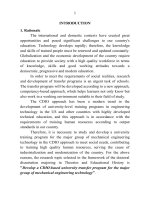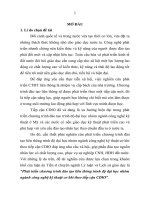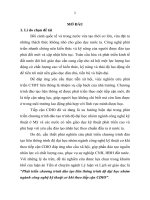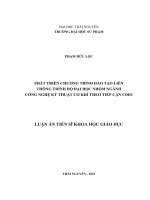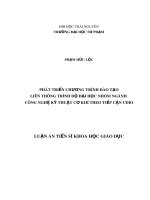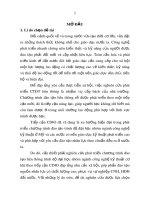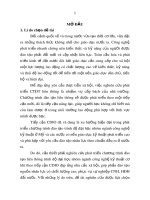Phát triển chương trình đào tạo liên thông trình độ đại học nhóm ngành công nghệ kỹ thuật cơ khí theo tiếp cận CDIO tt tiếng anh
Bạn đang xem bản rút gọn của tài liệu. Xem và tải ngay bản đầy đủ của tài liệu tại đây (717.96 KB, 28 trang )
1
INTRODUCTION
1. Rationale
The international and domestic contexts have created great
opportunities and posed significant challenges to our country's
education. Technology develops rapidly; therefore, the knowledge
and skills of trained people must be renewed and updated constantly.
Globalization and the economic development of the country require
education to provide society with a high quality workforce in terms
of knowledge, skills and good working attitudes towards a
democratic, progressive and modern education.
In order to meet the requirements of social realities, research
and development of transfer programs is an urgent task of schools.
The transfer program will be developed according to a new approach,
competency-based approach, which helps learners not only know but
also work in a working environment suitable to their field of study.
The CDIO approach has been a modern trend in the
development of university-level training programs in engineering
technology in the US and other countries with highly developed
technical education, and this approach is in accordance with the
requirements of training human resources according to output
standards in our country.
Therefore, it is necessary to study and develop a university
training program for the major group of mechanical engineering
technology in the CDIO approach to meet social needs, contributing
to training high quality human resources, serving the cause of
industrialization and modernization of the country. For the above
reasons, the research topic selected in the framework of the doctoral
dissertation majoring in Theories and Educational History is
"Develop a CDIO-based university transfer program for the major
group of mechanical engineering technology”.
2
2. Aims of the research
Study the theoretical and practical basis for developing the
university transfer programs in CDIO approach and on that basis
propose measures to develop the university transfer program for the
major group of mechanical engineering technology according to
CDIO approach.
3. Objects and subjects of the study
Objects of the study: College/University level training program
of mechanical engineering technology in the national education
system.
Subjects of the study: Measures to develop college-touniversity transfer programs for the major group of mechanical
engineering technology under CDIO approach.
4. Scientific hypothesis
Transfer training at university level has had initial results but
still faces many difficulties, limitations and shortcomings. The
university transfer programs in Vietnam has not really been
formulated according to a scientific and rational process to meet the
requirements of production practices and social needs. If the
development university transfer programs for the major group of
mechanical engineering technology under CDIO approach is
scientific, reasonable and practical, it will help universities and
colleges train students with high skills in design, operation and
creativity. This will contribute to ensuring and gradually improving
the quality of transfer training at university-level, responding to very
rapid changes in the progress of science and technology and demand
of highly qualified technical human resources for the cause of
industrialization and modernization and international integration of
the country.
3
5. Research tasks and contents
5.1. Research theoretical basis for developing university-level
training programs; CDIO approach to developing university transfer
programs for the major group of mechanical engineering technology.
5.2. Investigate and evaluate the status of university transfer
programs for the major of mechanical engineering tecahnology at
universities and colleges.
5.3. Study and propose measures to develop university transfer
programs for the major of mechanical engineering technology
according to CDIO approach.
5.4. Experiment was consulted with experts on the proposed
measures. Develop a draft structure of the university transfer
programs for the major of mechanical engineering technology
according to CDIO approach between Ly Tu Trong College of Ho
Chi Minh City and Ho Chi Minh City University of Technology.
6. Scope of the study
The thesis focuses on researching and developing a university
transfer program for the major of Machinery Manufacturing Technology
in the major group of mechanical engineering technologies according
to CDIO approach.
Scope of the survey: some universities and colleges in Ho Chi
Minh City.
Time of the survey: academic years 2016 - 2018.
7. Methodology and research methods
7.1. Methodology and approach
The thesis is based on historical and dialectical materialist
views with the following major approaches: systematic approach;
CDIO approach; practical approach; developmental approach;
transfer approach.
7.2. Research Methods
4
7.2.1. Theoretical research methods
Analyze, compare, synthesize, systematize and generalize
scientific monographs, research works, domestic and international
theoretical materials.
7.2.2. Practical research methods
- Practical research methods;
- Methods of studying activity products;
- Investigation methods;
- Interview methods;
- Expert methods;
- Methods of summarizing experience.
7.2.3. Supplementary methods
Mathematical statistics methods used tools and softwares for
statistics, data processing and calculations, etc. in assessing the
current status of university transfer programs for the machinery
manufacturing technology major of universities in Ho Chi Minh City.
8. Research questions
Are there difficulties and limitations in the training program at
university level in general and university transfer programs for the
major group of mechanical engineering technology in particular?
What are the characteristics of the CDIO approach in
developing training programs for the majors of engineering
technologies?
Is this approach consistent with the characteristics and
requirements of developing university transfer programs for the
major group of mechanical engineering technology?
What measures should be taken to develop university transfer
programs for the major of machinery manufacturing technology in
CDIO approach scientifically, practically and feasibly?
5
9. New contributions of the research
9.1. Theoretical contributions
The thesis has:
- systematized the theoretical basis for developing university
transfer programs for the major group of mechanical engineering
technology in CDIO approach.
- studied the general processes and methods to develop
university transfer programs in CDIO approach.
9.2. Practical contributions
The thesis has:
- proposed specific principles, standards, procedures and
measures to develop university transfer programs for the major of
machinery manufacturing technology according to CDIO approach.
- designed the framework of the university transfer program
for the major of machinery manufacturing technology according to
CDIO approach for Ly Tu Trong College of Ho Chi Minh City and
Ho Chi Minh City University of Technology.
These measures and university transfer program framework
can be considered as a model to build the framework for university
transfer programs of other disciplines in the major group of
mechanical engineering technology in CDIO approach.
10. The defense points
The CDIO approach to developing training programs in
general and transfer programs in particular is a modern curriculum
development approach and suitable to the major group of mechanical
engineering technology.
Applying CDIO approach to the development cycle of the
training program in developing university transfer programs will
contribute to improving the quality of training in accordance with
social needs and adapting with the modern environment.
The principles, standards and procedures of developing the
6
framework, curriculum and the essential contents of the university
transfer programs for the major of machinery manufacturing
technology following CDIO approach which are proposed in the
thesis serves as a scientific basis to build university transfer programs
for the major group of mechanical engineering technologies in
general and the major of machinery manufacturing technology in
particular according to CDIO approach.
Survey and assess the status of university transfer programs of
the machinery manufacturing technology major on the basis of
principles, standards and processes for developing university transfer
programs for the major of machinery manufacturing technology
according to CDIO approach.
The measures proposed in the thesis to develop university
transfer programs for the major group of machinery manufacturing
technology in the mechanical engineering technology group under
CDIO approach are highy relevant and feasible.
11. Structure of the thesis
The thesis includes the following sections: Introduction,
Contents, Conclusions, Recommendations, References and
Appendix.
The thesis content consists of 3 chapters:
- Chapter 1: Theoretical basis for developing university
transfer programs for the major group of mechanical engineering
technology under CDIO approach.
- Chapter 2: Current situation of developing university transfer
programs for the major of machinery manufacturing technology
under CDIO approach.
- Chapter 3: Measures to develop university transfer programs
for the major of machinery manufacturing technology according to
CDIO approach.
7
Chapter 1
THEORETICAL BASIS FOR DEVELOPING UNIVERSITY
TRANSFER PROGRAM FOR THE MAJOR GROUP OF
MECHANICAL ENGINEERING TECHNOLOGY IN CDIO
APPROACH
1.1. Overview of research on transfer training
and curriculum development
1.1.1. Foreign research works
The foreign research works on transfer training and curriculum
development have been done early by authors from many developed
countries, tested in practice and achieved good results.
1.1.2. Domestic research works
Many domestic research works on transfer training and
curriculum development have been studied with great interest by the
authors, but few have mentioned the development of transfer
programs; the development of transfer programs following CDIO
approach have not been studied in depth.
1.2. Some basic concepts
1.2.1. Training and training process
The training process is the process of organizing and
implementing the training tasks and contents with appropriate
methods, means, forms, resources and assessments to achieve the
training objectives.
1.2.2. Transfer
Transfer is the transition of two or more educational
institutions in a training community to help students move easily
from one level to another without having to repeat or lose credits.
1.2.3. Transfer training
Transfer training is a training process that recognizes and
converts academic results from one level to another or several other
levels in the training system to save time and training costs.
8
1.2.4. University training program
The university training program represents the goals of
university education and the regulations on the standards of
knowledge, skills, scope and structure of education and training
contents, training methods and forms, ways of evaluating training
results for each subject, major and training level.
1.2.5. University transfer program
The university transfer program is a type of transfer training
program with objectives, structure, contents and output standards at
university level.
1.2.6. Developing university transfer program
The development of university transfer programs must be based on
college training programs and university training programs to develop a
transfer program from college level to university level, inheriting the
knowledge and skills learned from college training programs.
1.2.7. Develop training programs according to CDIO approach
The development of training programs under the CDIO approach
bases on output standards: Graduate students need to have the required
knowledge, skills, qualities, attitudes and on that basis students form the
ability to meet the requirements or expectations of stakeholders.
1.3. The theoretical basis for developing curricuum according to
CDIO approach
1.3.1. Curriculum development cycle
Curriculum development is the process of identifying and
organizing all the activities of designing, implementing and
evaluating the training program in a logical and scientific cycle to
confirm the achievement of the desired goals.
1.3.2. Characteristics of CDIO approach in
curriculum development
Conceive: determine the initial requirements; choose the
technologies, strategies and rules; establish preliminary plans,
9
technical plans and other related plans.
Design: Focus on forming designs, including plans, drawings and
algorithms describing the product, and the procedure for implementation.
Implement: This is the stage of converting designs into
products, including the manufacture of hardware equipment, software
programming, inspection and approval.
Operate: Use the implemented products, processes or systems
to bring about the intended values, including maintenance,
development, reuse and elimination of the systems.
1.3.3. Develop a training program for the major group of
mechanical engineering technology under CDIO approach
Figure 1.1. Model for developing training programs
under CDIO approach
1.3.4. Principles for developing training programs according to
CDIO approach
The training program is designed with mutually supportive
subjects, with a clear plan to combine teaching knowledge and
training skills and attitudes for students.
10
The output standards of the training program are systematically
conveyed into the output standards in each subject and each learning
activity to ensure that the graduate students achieve the output
standards of the whole training program.
1.3.5. The procedure of developing curriculum
according to CDIO approach
Figure 1.2. The procedure of developing curriculum
in CDIO approach
1.4. The procedure of developing a university transfer program
for the major of mechanical engineering technology according to
CDIO approach
Step 1: Convert current university and college level training
programs into corresponding training programs under CDIO approach.
11
Step 2. Compare the output standards, general goals and
specific objectives of the college-level training programs with those
of the university-level training programs.
Step 3: Compare the structure and content of the training
programs according to the knowledge standards at college level with
those at university level.
Step 4: Base on CDIO standards and compare the performance
index (PI) of the two training programs.
Step 5: Build the structure of the transfer program in CDIO
approach from college level to university level.
Step 6: Consult experts and submit for the appraisement of the
university transfer program by competent authorities.
Step 7: Implement training courses according to the university
transfer program and evaluate regularly and periodically after each
training course.
1.5. Factors affecting the development of the university transfer
program for the major of machinery manufacturing technology
according to CDIO approach
Developing a university transfer program for the major of
machinery manufacturing technology according to CDIO approach
involves many factors: objective factors such as guidelines, policies and
mechanisms and regulations of law; subjective factors like managers’
and lecturers’ awareness of training programs of colleges and
universities, lecturers’qualifications and capacity to develop transfer
programs under the CDIO approach, teaching facilities and equipment,
and the relationship between transfer training institutions, etc.
Conclusion for Chapter 1
Developing a university transfer program for the major group
of machenical engineering technology according to CDIO approach
requires a strict procedure. This is really a big challenge for colleges
and universities in Vietnam. The results of studying literature review
12
and the theoretical basis for developing university transfer programs
for the majors of mechanical engineering technology create a
scientific basis for further research on the current status of
developing university transfer program for the major group of
mechanical engineering technology.
13
Chapter 2
CURRENT SITUATION OF DEVELOPING UNIVERSITY
TRANSFER PROGRAM FOR THE MAJOR OF MACHINERY
MANUFACTURING TECHNOLOGY IN CDIO APPROACH
2.1. General information about surveying and
assessing the situation
The survey on the current status of university transfer program for
the major group of mechanical engineering technology needs to determine:
- The survey object; the scope of the survey;
- The survey methods; the content of the survey.
2.2. Survey and evaluate the university-level training programs
in machinery manufacturing technology of universities in Ho Chi
Minh City
Figure 2.1. Results of surveying and evaluating university-level
training programs in machinery manufacturing technology of 3
universities in Ho Chi Minh City
14
On the basis of analyzing the evaluation chart, the universitylevel training programs in machinery manufacturing technology of
Ho Chi Minh City University of Technology is appreciated the most
highly. This training program is built according to CDIO approach;
therefore, it is selected as a standard training program for developing
university transfer programs in machinery manufacturing technology
according to CDIO approach.
2.3. The reality of college-to-university transfer programs in
machinery manufacturing technology
Figure 2.2. Results of assessing the reality of college-to-university
transfer programs in machinery manufacturing technology
The number of the responses Agree and Disagree concerning
college-to-university transfer programs in machinery manufacturing
technology of universities in Ho Chi Minh City is the same. This
means that the current training programs at university level are not
highly credited. Therefore, it is necessary to develop a transfer
15
program according to CDIO approach to achieve better results.
2.4. Assess the status of conditions to ensure the implementation
of
university
transfer
programs
in
machinery
manufacturing technology
Figure 2.3. Results of assessing the status of conditions to ensure
the implementation of university transfer programs in machinery
manufacturing technology
The status of conditions to ensure the implementation of
university transfer programs in machinery manufacturing technology
is quite good because of the high rate of Agree and Totally Agree
responses.
2.5. Assess the status of students' knowledge, skills and attitudes
under college-to-university transfer programs in machinery
manufacturing technology
16
Figure 2.4. Results of assessing the current status of students'
knowledge, skills and attitudes under college-to-university
transfer programs in machinery manufacturing technology
The current status of students' knowledge, skills and attitudes
under college-to-university transfer programs in machinery
manufacturing technology of universities in Ho Chi Minh City is
evaluated as Medium and Good at a high rate; however, the category
of Weak was still chosen, so it is necessary to update the transfer
programs for the most appropriate.
2.6. Current situation of developing college-to-university transfer
programs in machinery manufacturing technology under CDIO
approach
Current situation of developing college-to-university transfer
programs in machinery manufacturing technology:
- University transfer programs in machinery manufacturing
technology were developed on the basis of the university-level
curriculum framework and college-level curriculum framework
according to the curriculum of the Ministry of Education and
Training.
17
- Output standards, general objectives and specific objectives
have not been identified; stakeholders have not been surveyed to
build output standards; “ITU" and "blackbox" have not been
implemented to determine the sequence, relationship between
subjects in the training program.
- The amount of knowledge of the college training program and
the transfer program does not meet the entire knowledge of the
university training program.
- The performance indicators (PI) of the subjects at university
level have not been compared with those at college level, so it is
difficult to determine the content and knowledge for supplementary
subjects of the transfer program.
- The development of a detailed program of a subject is still
simple, not yet showing the teaching and learning methods, as well as
the content and form of examination and assessment of the subject, etc.
- Expert assessment after the construction and implementation
of the training program has not been taken seriously.
With the above remarks, the knowledge of students who are
trained under the college-to-university transfer programs in
machinery manufacturing technology cannot reach that of the
students under university-level programs. Therefore, it is necessary to
take measures to develop university transfer programs in a scientific
and modern way. One feasible solution is to develop college-touniversity transfer programs in the field of machinery manufacturing
technology according to CDIO approach.
2.7. Current situation of factors affecting the development of
university transfer programs in machinery manufacturing
technology in CDIO approach
At present, there have been many guidelines and policies to
18
encourage and regulate transfer training between levels of education,
the awareness of the managerial staff and lecturers, facilities,
teaching equipment, and other factors. These are very convenient
bases to develop university transfer programs in machinery
manufacturing technology in CDIO approach.
2.8. Overall assessment of the current status of the transfer
programs in machinery manufacturing technology
- From the training institution’s viewpoints
- From the learners’ viewpoints
- From the viewpoints of the employers recruiting students
trained under transfer programs.
Conclusion for Chapter 2
Through the analysis and evaluation of university-level
training programs in machinery manufacturing technology of
universities in Ho Chi Minh City, the results show that the universitylevel training program in machinery manufacturing technology of Ho
Chi Minh City University of Technology was highly appreciated and
this program was already built according to CDIO approach.
Therefore, this program can be used to develop a college-touniversity transfer program in machinery manufacturing technology
in CDIO approach from the program of Ly Tu Trong College of Ho
Chi Minh City.
There are still many shortcomings in developing university
transfer programs in machinery manufacturing technology; the
curriculum development does not follow a scientific process, so
students graduating from the university transfer programs in
machinery manufacturing technology do not meet the desired quality.
Therefore, it is necessary to take measures to develop university
transfer programs in machinery manufacturing technology according
to CDIO approach.
19
Chapter 3
MEASURES FOR DEVELOPING UNIVERSITY TRANSFER
PROGRAMS IN MACHINERY MANUFACTURING TECHNOLOGY
IN CDIO APPROACH
3.1. Measures to develop college-level training programs in
machinery manufacturing technology in CDIO approach at Ly
Tu Trong College of Ho Chi Minh City
3.1.1. Match the current training program with the
new output standards
The matching results are also the basis for adjusting the order
and content of subjects in the training program. The matching is
conducted by conducting surveys on teachers who teach the subjects
in the training program. The two surveys which were conducted are
"ITU" and "blackbox".
3.1.2. Design the framework of the college training program
The training program needs to be redesigned to have a proper
structure. The training program is structured by the subjects in the
group of general knowledge, basic professional knowledge and
professional knowledge.
3.1.3. Design teaching sequences
Reconstruct the knowledge block by semester to integrate
skills, create products, processes and systems into subjects
throughout the learning process. Personal, professional, teamwork
and communication skills, CDIO-related skills and designing
experiences are mainly integrated into subject projects.
3.1.4. Distribution of teaching sequences
The framework of the college training program in machinery
manufacturing technology in CDIO approach continues to determine
the position of the subjects, the previous subject, the following
20
subject, the prerequisite subject, the parallel subject, etc, hence,
developing a matrix for distributing subjects in a specific semester.
3.1.5. Design the detailed syllabus of the subjects
In the course of designing the course syllabus, lecturers can
change, reduce, and supplement the content of skills and attitudes
allocated to the subject. However, these contents must be ensured
throughout the training program.
3.2. Measures to build the framework of the college-to-university
transfer programs in machinery manufacturing technology
according to CDIO approach
3.2.1. Compare the general goals and specific objectives of the
training programs
Compare the general goals and specific objectives of the
training programs at college level with those at university level.
3.2.2. Compare the output standards and curriculum frameworks
at college level with those at university level
Compare the output standards and curriculum frameworks at
college level with those at university level in the major of machine
manufacturing technology, thereby building additional subjects in the
university transfer program in machinery manufacturing technology
according to CDIO approach.
3.2.3. Analyze and compare the knowledge content of the training
program in machinery manufacturing technology of University of
Technology with that of Ly Tu Trong College of Ho Chi Minh City
According to the CDIO approach, after comparing, analyzing
and synthesizing the knowledge content of the training programs, it is
possible to offer subjects that need to be supplemented to the collegeto-university transfer programs in machinery manufacturing
21
technology according to CDIO approach.
Table 3.1. Subjects in the college-to-university transfer programs
in machinery manufacturing technology in CDIO approach
Number of teaching periods
No.
Subjects
Credits
1
2
3
4
5
6
7
8
9
10
Analytics 2
Physics experiment
Physics 2
General Chemistry
English 3
English 4
Calculation method
Probability statistics
General informatics
Mechanical fluids
Thermodynamics and heat
transmission
Electrical - electronic
engineering
Automatic control
techniques
Mechanical drawing
Material handling
Manufacturing engineering 2
Manufacturing engineering 3
Quality assurance
Technical design process
Environment and Human
Business administration for
engineers
Manufacturing engineering
project
4
1
2
2
3
3
3
2
2
3
45
0
30
30
45
45
45
30
30
30
30
0
0
0
0
0
0
0
0
15
0
30
0
0
0
0
0
0
0
15
3
30
15
15
2
30
0
0
3
30
15
15
3
2
3
3
3
3
3
45
30
45
45
45
45
45
0
0
0
0
0
0
0
0
0
0
0
0
0
0
3
45
0
0
1
0
45
0
11
12
13
14
15
16
17
18
19
20
21
22
Theory Practice
Experime
nt
22
Number of teaching periods
No.
23
Subjects
Graduation Paper
TOTAL
Credits
7
64
Theory Practice
0
765
0
120
Experime
nt
315
390
3.2.4. Distribution of the university transfer programs in
machinery manufacturing technology according to CDIO
approach
The distribution of the subjects by semester for the university
transfer program in machinery manufacturing technology according
to CDIO approach is shown in Figure 3.1.
23
Figure 3.1. Distribution of the university transfer
program in machinery manufacturing technology
according to CDIO approach
3.3. Measures to assess the college-to-university transfer program
in machinery manufacturing technology according
to CDIO approach
24
3.3.1. Organize the first expert workshop to assess the framework
of the college-to-university transfer program in machinery
manufacturing technology according to CDIO approach
The first expert assessment workshop had 26 experts from
universities, institutes and enterprises.
General assessment: Pass: 95%; Fail: 0.3%; No comments: 4.7%
Standard 1: General goals and specific objectives
For this standard, 94.9% of the votes is Pass; 0.8% is Fail and
4.2% No comments.
Standard 2: Volume and placement of subjects
For this standard, 95.4% of the votes are Pass; 4.6% No comments.
Standard 3: Layout of the Curriculum Framework
For this standard, 94.6% of the votes are Pass; 5.4% No comments.
3.3.2. Organize the second expert workshop to assess the college-touniversity transfer program in machinery manufacturing
technology according to CDIO approach
The second expert evaluation workshop was organized with 32
experts from universities, institutes and enterprises.
Standard 1: Objectives and requirements of the training
program structure and content
In this standard, 97.1% of the experts and scientists rated from
Good or above. Specifically, the rate of Excellent is quite high (up to
88.6%).
Standard 2: Volume, structure and compulsory knowledge
content of the subjects
It was found that 94.3% of the experts and scientists rated this
standard Good or Excellent. No criteria were evaluated below the
average score. In particular, 82.9% of the experts and scientists rated
this standard at Excellent level.
Standard 3: Layout of the program framework documents and
their applicability
25
This standard is evaluated quite highly with 85.7% of the
experts and scientists selecting Good and Excellent. No criteria were
evaluated with below-average score.
Evaluation Results:
Excellent:
29/35
82.9%
Good:
5/35
14.2%
Fair:
1/35
2.9%
On level:
0/35
0%
Fail:
0/35
0%
Figure 3.2. Total evaluation scores on a scale of 10
Evaluation Results:
Thus, all the 3 standards and 25 criteria that were surveyed
received good evaluation from experts and scientists. The evaluation
scores ranging for 9.4 to 9.5 showed very high consistency in the
evaluation of the experts and scientists in the evaluation board.
Conclusion for Chapter 3

